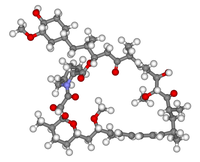
Upstream stimulating factor 1 suppresses autophagy and hepatic lipid droplet catabolism by activating mTOR
Sign Up to like & getrecommendations! Published in 2018 at "Febs Letters"
DOI: 10.1002/1873-3468.13203
Abstract: Previous studies indicate that the transcription factor upstream stimulating factor 1 (USF1) is involved in the regulation of lipid and glucose metabolism. However, the role of USF1 in lipid‐induced autophagy remains unknown. Interestingly, we found… read more here.
Keywords: suppresses autophagy; stimulating factor; upstream stimulating; mtor ... See more keywords

Alpha‐lipoic acid inhibits lung cancer growth via mTOR‐mediated autophagy inhibition
Sign Up to like & getrecommendations! Published in 2020 at "FEBS Open Bio"
DOI: 10.1002/2211-5463.12820
Abstract: Lung cancer is the leading cause of cancer‐related death, and there remains a need for novel therapies for this malignancy. Here, we examined the effects of alpha‐lipoic acid (LA), a drug used for treating human… read more here.
Keywords: cancer; cancer growth; mtor; lung cancer ... See more keywords

A comparative molecular dynamic simulation study on potent ligands targeting mTOR/FRB domain for breast cancer therapy.
Sign Up to like & getrecommendations! Published in 2021 at "Biotechnology and applied biochemistry"
DOI: 10.1002/bab.2206
Abstract: Our study aimed to develop and find out the best drug candidate against the mechanistic target of rapamycin (mTOR/FRB) domain having a critical role in the aetiology of breast cancer. The FRB domain in the… read more here.
Keywords: frb domain; mtor; breast cancer;

Advanced oxidation protein products mediate human keratinocytes apoptosis by inducing cell autophagy through the mTOR–Beclin‐1 pathway
Sign Up to like & getrecommendations! Published in 2022 at "Cell Biochemistry and Function"
DOI: 10.1002/cbf.3749
Abstract: Excessive keratinocyte apoptosis leads to impaired wound healing. Recently, advanced oxidation protein products (AOPP) have been recognized as a marker of oxidative stress and a potent inducer of apoptosis. Previously, we have demonstrated that extracellular… read more here.
Keywords: oxidation protein; cell; apoptosis; advanced oxidation ... See more keywords

Sphingomyelin in microdomains of the plasma membrane regulates amino acid‐stimulated mTOR signal activation
Sign Up to like & getrecommendations! Published in 2018 at "Cell Biology International"
DOI: 10.1002/cbin.10941
Abstract: Sphingomyelin (SM) is required for cells to proliferate, but the reason is not fully understood. In order to asses this question, we employed a cell line, ZS, which lacks both SMS1 and SMS2, isolated from… read more here.
Keywords: amino acid; stimulated mtor; mtor; mtor signal ... See more keywords

Chrysin promotes angiogenesis in rat hindlimb ischemia: Impact on PI3K/Akt/mTOR signaling pathway and autophagy
Sign Up to like & getrecommendations! Published in 2022 at "Drug Development Research"
DOI: 10.1002/ddr.21954
Abstract: Limb ischemia occurs due to obstruction of blood perfusion to lower limbs, a manifestation that is associated with peripheral artery disease (PAD). Angiogenesis is important for adequate oxygen delivery. The present study investigated a potential… read more here.
Keywords: akt mtor; mtor; pi3k akt; chrysin ... See more keywords

Anlotinib improves bile duct ligature‐induced liver fibrosis in rats via antiangiogenesis regulated by VEGFR2/mTOR pathway
Sign Up to like & getrecommendations! Published in 2022 at "Drug Development Research"
DOI: 10.1002/ddr.22019
Abstract: Cholestasis is a main clinical feature of biliary atresia (BA), which leads to liver fibrosis (LF). The focus of BA treatment is preventing and slowing the progress of LF. This study reports the improvement effect… read more here.
Keywords: anlotinib; expression; effect anlotinib; phospho ... See more keywords

The TSC1‐mTOR‐PLK axis regulates the homeostatic switch from Schwann cell proliferation to myelination in a stage‐specific manner
Sign Up to like & getrecommendations! Published in 2018 at "Glia"
DOI: 10.1002/glia.23449
Abstract: Proper peripheral myelination depends upon the balance between Schwann cell proliferation and differentiation programs. The serine/threonine kinase mTOR integrates various environmental cues to serve as a central regulator of cell growth, metabolism, and function. We… read more here.
Keywords: schwann; cell proliferation; schwann cell; mtor ... See more keywords

Mek/ERK1/2‐MAPK and PI3K/Akt/mTOR signaling plays both independent and cooperative roles in Schwann cell differentiation, myelination and dysmyelination
Sign Up to like & getrecommendations! Published in 2021 at "Glia"
DOI: 10.1002/glia.24049
Abstract: Multiple signals are involved in the regulation of developmental myelination by Schwann cells and in the maintenance of a normal myelin homeostasis throughout adult life, preserving the integrity of the axons in the PNS. Recent… read more here.
Keywords: erk1 mapk; mek erk1; mtor; myelination ... See more keywords

DEP domain–containing mTOR–interacting protein suppresses lipogenesis and ameliorates hepatic steatosis and acute‐on‐chronic liver injury in alcoholic liver disease
Sign Up to like & getrecommendations! Published in 2018 at "Hepatology"
DOI: 10.1002/hep.29849
Abstract: Alcoholic liver disease (ALD) is characterized by lipid accumulation and liver injury. However, how chronic alcohol consumption causes hepatic lipid accumulation remains elusive. The present study demonstrates that activation of the mechanistic target of rapamycin… read more here.
Keywords: liver; mtorc1; mtor; liver injury ... See more keywords

mTOR Signaling in X/A‐Like Cells Contributes to Lipid Homeostasis in Mice
Sign Up to like & getrecommendations! Published in 2019 at "Hepatology"
DOI: 10.1002/hep.30229
Abstract: Gastric mechanistic target of rapamycin (mTOR) signaling is inversely associated with the expression and secretion of ghrelin, a 28‐aa peptide hormone produced by gastric X/A‐like cells. Ghrelin contributes to obesity and hepatic steatosis. We sought… read more here.
Keywords: like cells; mtor signaling; mtor; signaling like ... See more keywords